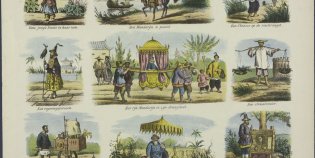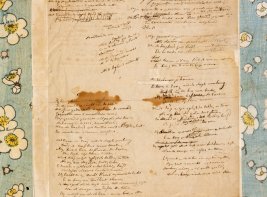Catchpenny prints
Overview of the catchpenny prints collection
- Contents: collection of catchpenny prints, part of the children’s book collection.
- Size: 5.000 items.
- Access: the prints can be searched and requested for viewing through the Centraal Bestand Kinderboeken (CBK)/Central Database of Children’s Books or the KB catalogue. Many prints have been digitised and are available online.
- More information: Karin Vingerhoets
What are catchpenny prints?
Catchpenny prints were cheap prints. They were used between 1730 and 1930 as newspapers, illustrations or comics. They were intended for children or for people who did not have much money. They were sold individually. Teachers also sometimes gave prints to their pupils as rewards. They were sold for 1 or more pennies. They are also called children’s prints or mannekensbladen.
Catchpenny prints were produced in large numbers on cheap paper. To save costs, prints were often sold without colour or with only a few colours. Catchpenny prints were published in series. They are printed on 1 side on unfolded sheets of printing paper (broadsheets). The prints measure about 30 by 40 centimetres and contain 1 or more images with text. The images are the most important part. The texts are short and often in rhyme. We do not know who created the illustrations and texts, but the publishers and printers are known.
History of the catchpenny prints collection
Hundreds of millions of catchpenny prints were printed and distributed in the Netherlands and Flanders. Yet unfortunately they have been poorly preserved. The quality of the paper was not good. In addition, for a long time, heritage institutions and private collectors had little interest in catchpenny prints.
The KB’s collection now includes about 5.000 catchpenny prints from the period 1730-1900. The collection consists of many donations and a few purchases. Aernout Borms and Leny Borms-Koop donated some 2.500 catchpenny prints to the KB in 2007 and 2016. This was followed by a donation of 170 prints by Frits and Tineke Gerssen in 2017. The Dutch Open Air Museum in Arnhem also often gives the KB duplicate catchpenny prints from its collection. Donations are still very welcome.
Accessibility of the catchpenny prints collection
You can search for the prints in the CBK or the KB catalogue. The prints are not lent out. However, they are made available on loan to museums and other institutions. KB customers can request to view the prints in the Special Collections reading room. Many prints have been digitised and are available online so you can view them on your screen at home. The links can be found in the CBK and in the KB catalogue.
Subjects depicted in catchpenny prints
Catchpenny prints cover a variety of subjects. There are many prints with individual images, for example of ships, soldiers, animals, food, tools, occupations, and distant peoples. There are also narrative prints featuring fairy tales, murder stories, farces, historical events, Bible stories and much more. A selection of occupations can be found on this Pinterest board.
Literature about the catchpenny print collection
Books
- Boerma, N. Borms, A., Thijs, A. & Thijssen, J. Kinderprenten, volksprenten, centsprenten, schoolprenten, populaire grafiek in de Nederlanden 1650-1950. Vantilt, 2014.
- Borms, A. Centsprenten: massaproduct tussen heiligenprent en stripverhaal. Uitgeverij d’Jonge Hond, 2010.




